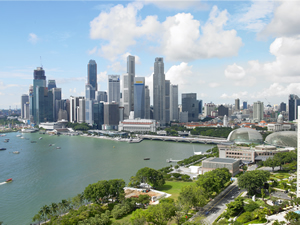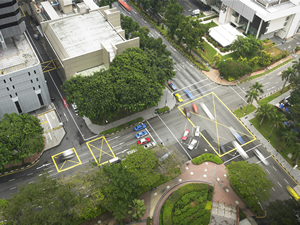Singapore Nets an Integrated Government with Server GIS Technology
By Matt Freeman, Esri Writer
 The island of Singapore is home to LandNet, a spatial data-sharing portal that promotes data sharing among 15 government agencies. |
In Singapore, the GIS-based Land Information Network (LandNet) acts as an online GIS data warehouse for government agencies. This spatial data-sharing portal, created by the Singapore Land Authority (SLA), propels interagency information sharing to a high level by providing a real-time data exchange platform.
And a shared infrastructure such as LandNet helps the government save money. Estimates show that without LandNet, the agencies would have to collectively spend more than $9 million in development costs and $2.5 million for annual maintenance to enjoy the same capabilities and benefits that LandNet offers.
Using the data and online sharing capabilities that LandNet supplies, agencies can provide, via the Web, a myriad of information to the public: Property data such as whether a plot of land is publically or privately owned, detailed street maps that show the locations of buildings and parks, and dengue fever cluster maps that pinpoint where the risk of contracting the disease is highest.
Thirst for Spatial Data
A high demand exists today for spatial data to use when managing security, environmental hazards, and health risks and conducting land-use and resource planning and management. As the island nation of Singapore moves toward its goal of an integrated government, there has been an effort by public agencies to collaborate on projects using online data sharing.
In 2007, with assistance from a few key agencies that supply data, such as the Land Transport Authority (LTA), Urban Redevelopment Authority (URA), Housing and Development Board (HDB), and Building and Construction Authority (BCA), SLA launched LandNet. It's a Web-based system that provides online updates and allows agencies to view, access, and perform spatial analysis and upload and download data directly from Singapore's legacy Land Data Hub (LDH).
 Singapore's Land Transport Authority uses LandNet to analyze traffic and roadway conditions. |
In essence, LandNet enables online data sharing among different agencies, even those that use different types of GIS systems-a feature that LDH alone did not possess. For agencies with their own customized GIS, LandNet acts as a virtual GIS data warehouse.
The LandNet system was an early adopter of the Esri ArcGIS Server map caching tools and its advanced, behind-the-scenes geoprocessing capabilities. LandNet was the first in the Asia-Pacific region to integrate GIS Web services with the Government Web Service Exchange (GWS-X). The marriage of the two allows government agencies to integrate maps into their Web sites without having to operate a GIS infrastructure.
LandNet makes it possible to view multiple types of spatial data-such as road lines, cadastral lots, landownership, and utilities data-using a Web browser, without the need for desktop GIS software. Even agencies without GIS can enjoy the use of spatial data without difficulty. Nonspatial types of data, such as socioeconomic statistics, can be layered easily with spatial data in LandNet. Satellite images can also be used as a backdrop for the spatial data.
LandNet's innovative features include access to data through a simple map browser with map view, query, and analysis tools. The map browser can be personalized based on user preference. Users can set the number and appearance of the layers they want to view each time they log in. LandNet also offers tools for map-based e-government. All these features allow government agencies to provide better online map services to the public.
Integrating Government Agencies to Serve the Public
LandNet makes available and promotes data and interagency connectivity nationwide. With its good interagency connectivity, GIS functionalities, and the ready availability of spatial data, LandNet has become the preferred GIS platform to support national initiatives and map-based applications in Singapore. LandNet has spurred the creation of many new applications and services such as
- Integrated Land Information Services
A visit to www.inlis.gov.sg allows citizens to purchase property- and land-related information from multiple agencies. Integrated Land Information Services (INLIS) uses LandNet as a conduit to pull GIS data from various agencies. For example, INLIS allows prospective property buyers and conveyance attorneys to obtain up-to-date information on landownership and future road-widening works that may affect property. Surveyors can receive information on the latest survey control points using a short message service (SMS) from INLIS to their mobile phones and hardware. INLIS handles more than 300,000 transactions annually. - SLA Map Portal
The SLA Map Portal, found at www.map.gov.sg, provides citizens with free street-level maps, information on landownership, and locations of free Wi-Fi hot spots. The site attracts more than 70 million hits per month. Many other government Web sites also take advantage of these map services to show the location of government facilities and services. LandNet provides the mechanism and the spatial database for the information to be delivered. - Dengue Hot-Spot Monitoring
At www.dengue.gov.sg, LandNet facilitates the fight against dengue by disseminating data on dengue hot-spot clusters detected by the National Environmental Agency (NEA). Timely sharing of such data with other agencies ensures that quick preventive actions can be taken to stop the spread of disease. - Next Generation National Broadband Network Planning
LandNet helps the Infocomm Development Authority (IDA) in the laying of cables for the Next Generation National Broadband Network. By making available essential spatial utilities and services data, the LandNet Web browser provides maps, allowing stakeholders to visualize utility network data such as underground sewerage, drainage, water, and gas. - State Properties Information Online
Built on LandNet's GIS platform, State Properties Information Online (SPIO) provides an up-to-date, map-based list of vacant state-owned properties available for rent or lease. With this information readily available, the use and occupancy rate of these state properties are maximized. - State Land Register
Government agencies can view and inquire about the listings of the agencies' state-allocated land and building inventory using State Land Register. Accessing data from LandNet, it facilitates the verification and certification of the listings to ensure accurate and complete records for accountability. - Land Resource Management and e-Services System
Serving citizens through better interagency coordination and e-consultation, the Land Resource Management and e-Services System integrates several back end land administration work processes. This is achieved by exploiting LandNet's interagency connectivity, which eliminates the need for the agencies to approach one another for land administration matters. - Environmental Protection
Government agencies exchange information about trees via LandNet to help maintain Singapore's "green city" status. Having updated spatial data about land helps the government deal with the geostrategic implications of climate change. Information gathered at LandNet helped to create Singapore's first landslide susceptibility maps.
 Spatial data, such as roadlines, cadastral lots, land ownership, and utilities data, can be viewed using just a Web browser. |
Unique Funding for a Unique Data Model
LandNet is maintained and operated on a cooperative funding model. Members share data as well as the operating costs. Agencies pay a yearly subscription and a download service fee on a pay-per-use basis. The income generated by the system is used to cover operating costs, and surplus income is returned to member agencies in the form of subscription fee rebates. The funding model's objective: ensure the program's sustainability and accountability.
Agencies That Use LandNet
Urban Redevelopment Authority
Building and Construction Authority
Land Transport Authority
JTC, Singapore's leading master planner, developer, and manager of high-quality industrial facilities and business parks
Housing and Development Board
Ministry of Environment and Water Resources
National Environment Agency
Public Utilities Board
People's Association
Ministry of Home Affairs
Ministry of Defense
Singapore Land Authority